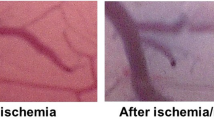Abstract
The aim of this study was to investigate the mechanism and site of action of betahistine dihydrochloride in the inner ear of the guinea pig. Betahistine-evoked increases in cochlear blood flow (CBF) have been presumed to be due to the drug effect on the later wall capillary bed or larger feeding vessels in the cochlea vascular system. As such, the mechanism of action could be due to inhibition of H3 receptors. Betahistine may also have a direct effect on postsynaptic H1/H2 receptors and/or an effect modulated by other autonomic receptors. Betahistine-evoked CBF responses were assessed by laser Doppler flowmetry in the presence of an H3 agonist (α N-methylhistamine dihydrochloride), an H3 antagonist (thioperamide), an H2 antagonist (cimetidine) or an α2 antagonist (idazoxan). The effects of betahistine on circulation in the anterior inferior cerebellar artery (AICA) and ipsilateral stria vascularis (SV) were assessed using intravital microscopy (IVM). Findings showed that betahistine increased CBF and reduced systemic blood pressure (BP). In contrast, α N-methylhistamine dihydrochloride had no effect on baseline CBF or BP and did not influence betahistine-induced increases in CBF. Thioperamide reversed the effects of betahistine on CBF, but had no effect on baseline CBF or BP. Cimetidine had no marked effect on baseline CBF or betahistine-induced increases in CBF Idazoxan had no consistent effects on baseline CBF, but abolished the effect of betahistine on CBF. The mean increase of red blood cell velocity in SV capillaries was 15% and occurred without a demonstrable change in capillary diameters. In contrast, the diameter of the AICA increased by 17–20%, indicating that betahistine-evoked increases in CBF resulted primarily from vasodilatation of the AICA. We suggest that this effect may be mediated via presynaptic H3 heteroreceptors and autonomic α2 receptors.
Similar content being viewed by others
Author information
Authors and Affiliations
Additional information
Received: 25 June 1997 / Accepted: 20 August 1997
Rights and permissions
About this article
Cite this article
Laurikainen, E., Miller, J., Nuttall, A. et al. The vascular mechanism of action of betahistine in the inner ear of the guinea pig. European Archives of Oto-Rhino-Laryngology 255, 119–123 (1998). https://doi.org/10.1007/s004050050025
Issue Date:
DOI: https://doi.org/10.1007/s004050050025




